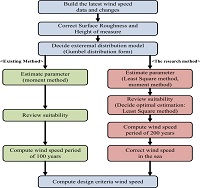Design Wind Speed Estimation for Long Span Bridges in Korean Southern and Western Coasts
DOI:
https://doi.org/10.46604/ijeti.2020.3545Keywords:
basic wind speed, return period wind speed, least-squares method, RMS error methodAbstract
Recently, many long-span cable supported bridges, including the cable stayed bridges and the suspension bridges, have already been constructed or are planned for construction. Because the meteorological values used to estimate the wind load for designing the long-span bridges were based on data from the 1960s through 1995 in Korea, it is necessary to reconsider the proper design wind load for long-span bridges. In this paper, the research area is confined to the southern and western coasts of Korea where many long-span bridges have been built. The method of moment and the least-squares method are used to estimate the expected wind speeds of a 100-year return period for girder bridges; Gumbel’s distribution is used to estimate the expected wind speeds of a 200-year return period for long-span bridges. As the return period wind speed on the land surface is revised because of recent high-speed velocity, the revised return period wind speed is increased by 17%. The compatibility of return period wind speed is also evaluated using the RMS (root mean square) error method. This paper concludes that the least-squares method is more compatible than the method of moment for the case of the southern and western coasts of Korea.
References
Korean Highway Bridge Design Code Limit state design, Ministry of Land, Infrastructure and Transport, Korea, 2014.
Design Guidelines for Steel Cable-Supported Bridge, Korean Society of Civil Engineers, 2006.
R. Rahnavard, M. Taghikhajeh, A. Hassanipour, and N. Siahpolo, “Parametric study of seismic performance of steel bridges pier rehabilitated with composite connection,” Journal of structure and construction engineering, vol. 10, pp. 98-113, 2017.
D. W. Kim and Y. C. Ha, “Estimation of wind speeds for return period in major cities reflecting the recent meteorological data,” Journal of the Wind Engineering Institute of Korea, vol. 8, pp. 147-154, 2004.
V. L. Brano, A. Orioli, G. Ciulla and S. Culotta, “Quality of wind speed fitting distributions for the urban area of Palermo, Italy,” Renewable Energy, vol. 36, pp. 1026-1039, March 2011.
O. A. Jaramillo and M. A. Borja, “Wind speed analysis in La Ventosa, Mexico: a bimodal probability distribution case,” Renewable Energy, vol. 29, pp. 1613-1630, August 2004.
T. B. M. J. Ouarda, C. Charron, J. Y. Shin, P. R. Marpu, A. H. Al-Mandoos, M. H. Al-Tamimi, H. Ghedira and T. N. Al Hosary, “Probability distributions of wind speed in the UAE,” Energy Conversion and Management, vol. 93, pp. 414-434, 2015.
J. Zhou, E. Erdem, G. Li and J. Shi, “Comprehensive evaluation of wind seed distribution models: A case study for North Dakota sites,” Energy Conversion and Management, vol. 51, pp. 1449-1458, 2010.
O. Alavi, A. Sedaghat, and A. Mostafaeipour, “Sensitivity analysis of different wind speed distribution models with actual and truncated wind data: A case study for Kerman, Iran,” Energy Conversion and Management, vol. 20, pp. 51-61, 2016.
E. K. Akpinar, S. Akpinar, and N. Balpetek, “Statistical analysis of wind speed distribution of Turkey as regional,” Journal of Engineering Technology and Applied Sciences, vol. 3, pp. 35-55, 2018.
X. Qing, “Statistical analysis of wind energy characteristics in Santiago island, Cape Verde,” Renewable Energy, vol. 115, pp. 448-461, 2018.
D. Cho, H. Jeong, and J. Choi, “A study of the bolt connection system for a concrete barrier of a modular bridge,” International Journal of Engineering and Technolgy Innovation, vol. 8, no. 2, pp. 107-117, April 2018.
M. E. Batts, L. R. Russell, and E. Simiu, “Hurricane wind speeds in the United States,” ASCE Journal of Structural Division, vol. 106, pp. 2001-2016, 1980.
Annual Weather Report, Korean Meteorological Administration, 1971-2017.
Korean Building Code-Structural (KBC2005), Architectural Institute of Korea, Chapter 3, 2005.
Revised Standard Project Hurricane Criteria for the Atlantic and Gulf Coast, Memorandum HUR 7-120, Hydrometeorological Branch Office of Hydrology, NOAA, National Weather Service, USA, 1972.
E. Simiu, J. Bietry, and J. J. Filliben, “Sampling errors in the estimation of extreme wind,” Journal of the Structural Division, ASCE, vol. 104, pp. 491-501, 1978.
E. Simiu and R. H. Scalan, Wind effects on structures: fundamentals and applications to design, 3rd ed. John Wiley and Sons, 1996.
S. S. Park, “A study on wind loads for bridges,” MA. dissertation, Dept. Civil Eng., Kyunghee Univ., Korea, 2004.

Published
How to Cite
Issue
Section
License
Copyright Notice
Submission of a manuscript implies: that the work described has not been published before that it is not under consideration for publication elsewhere; that if and when the manuscript is accepted for publication. Authors can retain copyright in their articles with no restrictions. Also, author can post the final, peer-reviewed manuscript version (postprint) to any repository or website.

Since Jan. 01, 2019, IJETI will publish new articles with Creative Commons Attribution Non-Commercial License, under Creative Commons Attribution Non-Commercial 4.0 International (CC BY-NC 4.0) License.
The Creative Commons Attribution Non-Commercial (CC-BY-NC) License permits use, distribution and reproduction in any medium, provided the original work is properly cited and is not used for commercial purposes.







.jpg)


